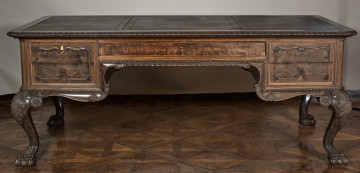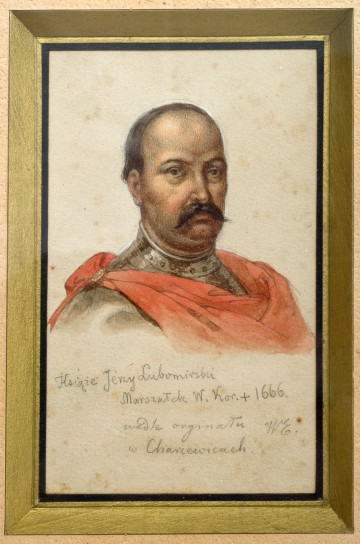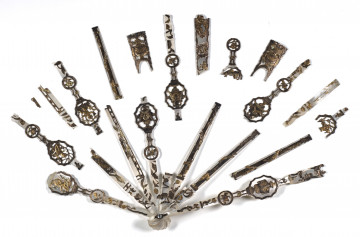
Desk
20th century
Castle Museum in Łańcut
Part of the collection: Furniture and interior furnishings
Fire has accompanied humanity for thousands of years. Already in prehistoric times, our ancestors lit bonfires where they prepared meals and warmed themselves. The glow of the fire also protected against attack by wild animals.
It is impossible to determine precisely when the first fireplaces appeared. It is generally accepted that it took place in the twelfth century. The fireplaces had the form of a hearth with a dome through which the smoke was discharged. With the popularization of fireplace systems, fireplaces began to be placed against the wall or in the corner of the room. In the 16th and 17th centuries, fireplaces became popular throughout Europe, including Poland. Brick, stone or tiles were used to build them. Therefore, they had not only a heating function, but also a decorative one. Of course, the first fireplaces were installed in aristocratic residences, and it was not until the eighteenth century that they began to appear in the homes of less wealthy citizens. Their equipment included: a screen covering the hearth, log racks, a poker and andirons. Fireplace andirons are decorative supports for firewood. They consist of a front part in the form of a plastic figure usually made of brass or bronze and an iron horizontal strip that serves as a support. The slat is fixed in such a way that the front part provides protection against possible slipping of burning wood. Thanks to the andirons, there is access to air from the underside of the stacked wood, which helps to keep the flame burning. Andirons were also used to install fireplace screens, and when they heated up, they became an additional source of heat.
The fireplace andirons, which are in our collection, were made in the style of Louis XVI in France in the second half of the nineteenth century. They consist of an iron strip that is attached to a decorative foot cast in gilded bronze. It is a cantilever-shaped casting with a stylized half-column on which a vase with a lid stands.
Anna Szczęsny
Author / creator
Object type
akcesoria kominkowe
Technique
rzemiosło artystyczne
Material
metal, steel
Creation time / dating
Owner
Muzeum - Zamek w Łańcucie
Identification number
Location / status

20th century
Castle Museum in Łańcut

XIX century
Castle Museum in Łańcut

koniec XVIII wieku
Castle Museum in Łańcut
DISCOVER this TOPIC
National Museum in Szczecin
DISCOVER this PATH
Educational path